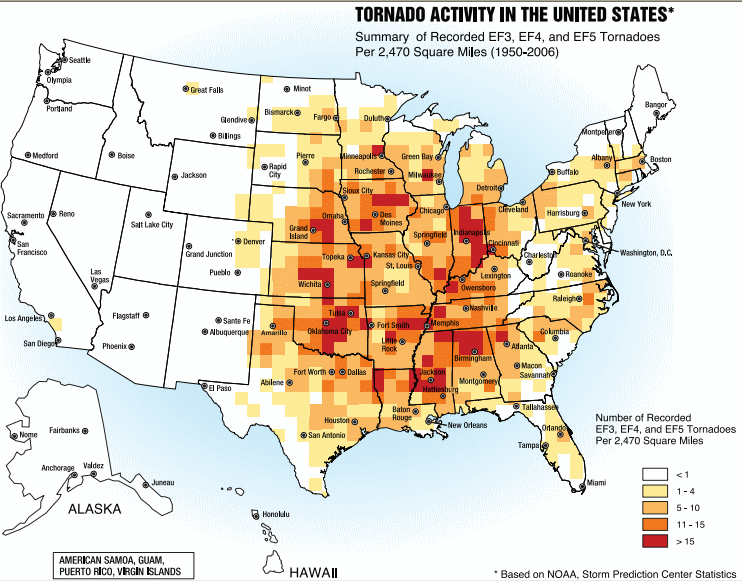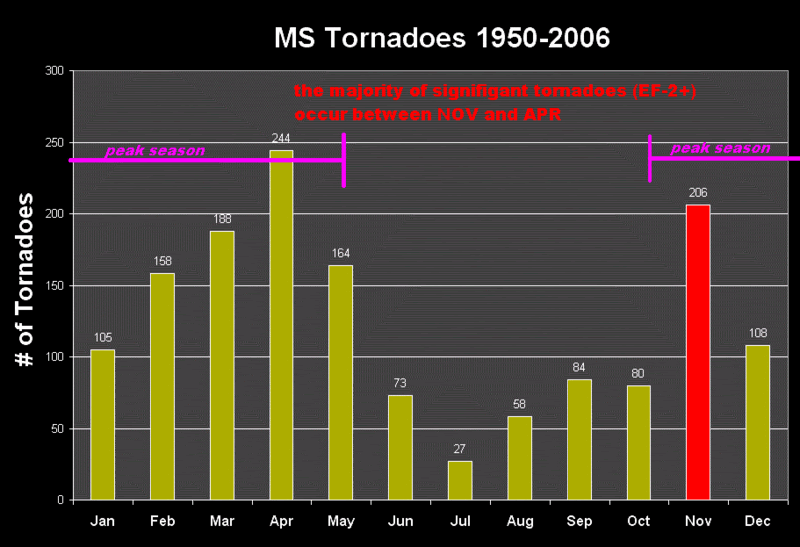Terry Tyler
EF5
I find chasing in the South to be a different experience than in the Central Plains. If youve got the equipment, logistically it might not be different. But the facts of Southeast severe weather events do not change. There are several factors that separate the Southeast from other states in their severe weather set-ups. One of the biggest obstacles is terrain. Depending on the State your chasing in, whether it be Mississippi, Alabama, Tennessee, or Arkansas. You will have to deal with the rolling hills and trees that plague the region. Since storms do not have reguard to political or geographical boundarys, sometimes you need to take a windy backroad, or state highway. Thats leads to the second problem. Storm motions are very high. Almost all of the major south-east events occur during the transitional months. These storms often form in low CAPE, low instability environments and are often dominated by the extremely powerful deep-layer shear in the atmosphere. They move in speeds upward of 50mph and can be as strong as any Central plains storm. The third thing is the road network. Most of the roads really arent that bad, but in some parts of some states the visibility is unacceptable. If your left to taking state highways and backroads, they can weave and wind, be subject to being blocked due to flash flooding, downed trees or other hazards. Plus they limit the speed your able to drive. When your trapped on one of those winding roads, there is no other alternative. You cant drive faster then the road will let you, and you can become trapped in the path of the storm.

With that said, there are alot of great places to chase in the south. Some places are over grown but there are places where you can get some incredible views of storms. Some of the best spots ive seen for storms are around eastern, AR and the delta in Mississippi. Terrain out there is almost plains like, and you can see for miles. Assuming its not one of those rainy stratified set-ups.

A place i always hope a storm forms is locally. Here in Northeast, MS we have a special geographical feature called the black prairie. This place is rich in soil and nutrients and is very flat. You can ride 45 South from Tupelo past Verona and go all the way past Shannon and towards West Point. The terrain down that way is almost as close as your going to get to the plains, and even beats some places out there. This link includes some information about that black prairie for those who are interested. I learned about it in my Mississippi studies class.
http://mississippientomologicalmuse...itats/black.belt.prairie/BlackBeltPrairie.htm
The last big thing about events in the south is the big thing about any other severe weather event. The timing is critical. Since over %60 of southeast tornadoes occur during transitional months, some events occur at night leading to the lack of documentation and chasability. I can tell you, ive waited on lines to come across the Mississippi river only to find them get warned when the sun goes down at 5PM. When you factor in all the different varibles into a chase out here, theres alot more then just the set-up itself. You try to hope a storm forms in a good visibility location, with limited or no cloud cover. Its rare, but events like 11/15/05 and 5/2/08 have provided limited cloud cover, but nothing like a dry-line type set up. Dixie alley tornadoes are particularly deadly, mainly because of the aforementioned reasons. Leading scientists and researchers claim that the reason for the large amount of fatalities in Southern states is because of the population density, the time of day, and because alot of people live in modular homes. When you factor in the terrains visibility, the cloud cover, the time of day, the speed the storms are travelling and the roads the storms are on. Its not hard to see the difference.
Heres some information on some Southern severe weather events.
http://alagenealogy.com/Historical ...ormation/Magazine Article of Tornado 1932.htm
http://www.usatoday.com/weather/tornado/wtordead.htm
http://www.srh.noaa.gov/srh/srnews/stories/2008/mississippi.htm
One can look at a graph of tornadoes on a national level, and see no distinction in the number of storms per state. Northeast, MS can hold its own with Central, OK


Events in the late season provide a higher chance of severe weather during the off hours. Wont lie and say im a weather expert because im self taught, but thats how i feel about the subject and thats all i got to say about that.

With that said, there are alot of great places to chase in the south. Some places are over grown but there are places where you can get some incredible views of storms. Some of the best spots ive seen for storms are around eastern, AR and the delta in Mississippi. Terrain out there is almost plains like, and you can see for miles. Assuming its not one of those rainy stratified set-ups.

A place i always hope a storm forms is locally. Here in Northeast, MS we have a special geographical feature called the black prairie. This place is rich in soil and nutrients and is very flat. You can ride 45 South from Tupelo past Verona and go all the way past Shannon and towards West Point. The terrain down that way is almost as close as your going to get to the plains, and even beats some places out there. This link includes some information about that black prairie for those who are interested. I learned about it in my Mississippi studies class.
http://mississippientomologicalmuse...itats/black.belt.prairie/BlackBeltPrairie.htm
The last big thing about events in the south is the big thing about any other severe weather event. The timing is critical. Since over %60 of southeast tornadoes occur during transitional months, some events occur at night leading to the lack of documentation and chasability. I can tell you, ive waited on lines to come across the Mississippi river only to find them get warned when the sun goes down at 5PM. When you factor in all the different varibles into a chase out here, theres alot more then just the set-up itself. You try to hope a storm forms in a good visibility location, with limited or no cloud cover. Its rare, but events like 11/15/05 and 5/2/08 have provided limited cloud cover, but nothing like a dry-line type set up. Dixie alley tornadoes are particularly deadly, mainly because of the aforementioned reasons. Leading scientists and researchers claim that the reason for the large amount of fatalities in Southern states is because of the population density, the time of day, and because alot of people live in modular homes. When you factor in the terrains visibility, the cloud cover, the time of day, the speed the storms are travelling and the roads the storms are on. Its not hard to see the difference.
Heres some information on some Southern severe weather events.
http://alagenealogy.com/Historical ...ormation/Magazine Article of Tornado 1932.htm
http://www.usatoday.com/weather/tornado/wtordead.htm
http://www.srh.noaa.gov/srh/srnews/stories/2008/mississippi.htm
One can look at a graph of tornadoes on a national level, and see no distinction in the number of storms per state. Northeast, MS can hold its own with Central, OK


Events in the late season provide a higher chance of severe weather during the off hours. Wont lie and say im a weather expert because im self taught, but thats how i feel about the subject and thats all i got to say about that.
Last edited by a moderator:







